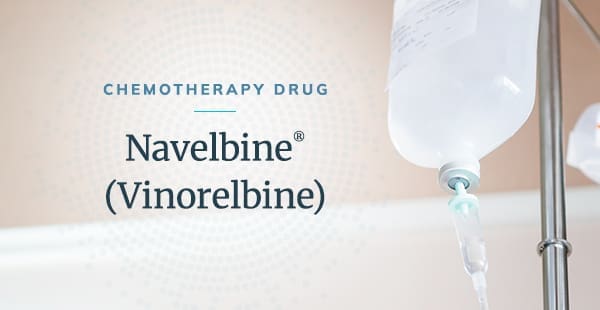What Is Navelbine (Vinorelbine)?
Navelbine® (vinorelbine) is a chemotherapy drug. It belongs to a group of drugs called vinca alkaloids, which were originally derived from the periwinkle plant.
Chemotherapy drugs target different mechanisms that can enable cancer cell growth. Vinorelbine mainly targets a specific type of protein called a microtubule. Microtubules form part of the physical structure necessary for cellular growth and division.
Vinorelbine is sometimes used as part of a mesothelioma treatment plan. It has been tested primarily in pleural mesothelioma patients.
Resources for Mesothelioma Patients
How Does Navelbine (Vinorelbine) Treat Mesothelioma?
Vinorelbine is a chemotherapy drug that interferes with cell growth. Mesothelioma patients may receive it as part of their treatment plan. Vinorelbine is not a common chemotherapy drug for mesothelioma. However, certain patients may benefit from it. For example, vinorelbine may be an option for patients who did not respond well to other first-line treatment options. Mesothelioma doctors can determine if vinorelbine treatment might be appropriate.
Vinorelbine works by targeting a specific protein that enables cell division. It may also cause cancer cell death by interfering with DNA and RNA synthesis. This can hinder cancer cell growth.
Combining vinorelbine with other chemotherapy drugs may result in more effective treatment. For example, it is sometimes used with cisplatin. Vinorelbine and cisplatin use different mechanisms to kill fast-dividing cancer cells. Combining drug mechanisms this way increases the chance of eliminating all cancer cells.
Navelbine (Vinorelbine) for Pleural Mesothelioma
There is currently no standard treatment for mesothelioma using vinorelbine. Research has examined ways it may offer benefits for treating malignant pleural mesothelioma. Researchers have investigated vinorelbine in the following instances:
- First-line treatment: Vinorelbine has been used as a first-line treatment. Doctors may use it as a single agent or in combination with another chemotherapy drug.
- Second-line treatment: Vinorelbine has been used as a second-line treatment. It may be offered as a single agent in this context. It may also be an option for patients who are not eligible for clinical trials.
Studies of vinorelbine for pleural mesothelioma have shown a median survival from about 6 to 17 months. This range includes patients treated with vinorelbine alone and in combination with other drugs. Several studies have combined vinorelbine with more standard forms of mesothelioma chemotherapy treatment.
- One study used vinorelbine after a regimen of platinum chemotherapy plus pemetrexed. Median overall survival was about 6 months.
- Another study used vinorelbine as a single agent in first-line treatment. Results showed pleural mesothelioma patients had a median overall survival of almost 14 months.
- Another study used vinorelbine for pleural mesothelioma patients ineligible for surgery. In the study, researchers combined vinorelbine and cisplatin as a first line of treatment. Median overall survival was almost 17 months.
Researchers continue to study vinorelbine’s use as a mesothelioma treatment. It has U.S. Food and Drug Administration (FDA) approval for non-small cell lung cancer (NSCLC). It is not currently approved to treat other diseases, such as mesothelioma. However, vinorelbine has been studied as a treatment option for:
- Breast cancer
- Cervical cancer
- Hodgkin lymphoma
- Mesothelioma
- Multiple myeloma
Currently, vinorelbine is not a common form of mesothelioma treatment. But it may be useful in certain situations. Mesothelioma doctors can decide if vinorelbine is an appropriate treatment.
What to Expect During Treatment
Vinorelbine is one of several different options for mesothelioma chemotherapy treatment. It is administered intravenously. Patients can expect to receive treatment under the supervision of a healthcare professional.
Vinorelbine may be administered alone or in combination with other chemotherapy drugs. A specialist can determine which combination is most appropriate for a patient. Infusions generally occur over the course of six to ten minutes. They are administered in specific dosages and on a fixed schedule. Dosages may vary based on the type of cancer. Some FDA-approved dosages for NSCLC are as follows:
Healthcare providers attend to patients during infusions. They track vitals to help address problems if they occur. Patients can also alert providers to any discomfort they may feel during their infusion.
Patients may undergo several cycles of treatment. A doctor will determine how many cycles are appropriate. The number of cycles can depend on how well a patient responds to vinorelbine. A doctor may decide whether to stop treatment if risky side effects occur.
Preparing for Your Appointment
There are several ways mesothelioma patients can prepare for their vinorelbine chemotherapy appointment. Preparation may help reduce stress and discomfort and help avoid any unnecessary complications. In the lead up to their appointment, patients can ask their doctor questions about treatment.
To prepare for their chemotherapy appointment, mesothelioma patients may also want to:
- Arrange transportation: Patients may feel low-energy or drowsy after their infusion. They may want to arrange a safe ride from the hospital. Transportation services may be available if a friend or family member cannot provide a ride.
- Arrange to bring a companion: Facilities often allow patients to bring a friend or family member to their appointment. Companions can keep patients company, help ask questions and take notes.
- Dress comfortably: Patients can limit discomfort during infusions by dressing in layers and non-constrictive clothing.
- Pack a bag: Patients may get hungry, thirsty or bored during infusions. Packing a bag with certain items may make treatment less uncomfortable. Patients may want to pack snacks, a small meal or a beverage. Crafts and reading materials may also help with boredom.
- Prepare a relaxing post-infusion schedule: Patients may want to spend time resting and recovering after their appointment. A friend or family member may be able to help with chores, errands and meal preparation. Patients may also want to notify their employer that they may need time off.
Healthcare providers may also ask patients about their cancer journey during their appointment. This can help them provide better care. Patients may want to organize their medical documents in one place. This can help avoid stress and create a smoother appointment experience.
Managing Treatment and Follow-Up Care
Patients may go through multiple treatment cycles with vinorelbine. Doctors have several ways to manage complications.
Mesothelioma doctors may give patients treatment-management instructions. Patients should make sure to follow any instructions. To take care of themselves during treatment, patients may also want to:
- Avoid large crowds or sick people to help prevent infection
- Drink plenty of fluids to avoid dehydration
- Use caution when doing tasks that need mental alertness until the side effects of vinorelbine are known
- Wash hands to reduce the risk of infection
It is also important for patients to attend follow-up appointments with their doctors. These appointments are an opportunity to discuss and address any treatment side effects. Doctors will be able track mesothelioma patients’ progress. They may draw blood to check blood cell levels and organ functions. Doctors can also help manage side effects and determine if it is safe to continue treatment.
Navelbine (Vinorelbine) Benefits
Vinorelbine may benefit mesothelioma patients in certain situations. This chemotherapy is generally well-tolerated. This means it has a relatively low incidence of side effects compared to other chemotherapy drugs. As a result, it may be an option for patients who are unable to handle negative side effects associated with other treatments. It may also be useful as a second-line therapy for patients ineligible for clinical trials.
Vinorelbine is not a common mesothelioma treatment. Its benefits for mesothelioma have not been fully explored. At least one study found promising survival results for patients with pleural mesothelioma. Patients who received a first-line treatment of cisplatin and vinorelbine had a median survival of 16.8 months. It is possible that future studies will reveal further benefits. Mesothelioma researchers are always looking for more effective treatments for this rare disease.
Navelbine (Vinorelbine) Side Effects
Mesothelioma patients who receive vinorelbine treatment may experience side effects. Common side effects include anemia, nausea, vomiting and weakness. Different factors may result in a variety of side effects. For example, drug and therapy combinations may cause different side effects than treatment with vinorelbine alone.
Neutropenia is a potential side effect of vinorelbine. It is an abnormally low count of white blood cells called neutrophils. If this side effect occurs, doctors may reduce dosage or pause treatment altogether. This condition can make people more susceptible to infection. Discontinuing vinorelbine usually has a positive effect on white blood cell count. Doctors generally check patients for neutropenia before each dose of vinorelbine.
Patients can ask mesothelioma doctors about side effects before treatment. Doctors can help manage side effects and adverse events as they occur.
Managing Side Effects
A mesothelioma patient’s healthcare team can help manage vinorelbine treatment side effects. A patient should speak to their doctor if they experience any adverse reactions. A doctor can assess the situation and provide recommendations to improve the patient’s quality of life.
Nausea and vomiting are common vinorelbine treatment side effects. Adjusting nutrition during and after chemotherapy can help manage nausea. A doctor may also prescribe anti-nausea medication. Patients should make sure they take any medication as prescribed.
Another common vinorelbine side effect is constipation. Patients are advised to follow a diet rich in fiber and stay hydrated. They may also use stool softeners. A dietitian may be able to recommend a diet plan to help with symptoms and maintain nutrition during treatment.
Certain drugs and supplements may claim to help with treatment side effects. These include:
- Herbs
- Minerals
- Over-the-counter drugs
- Vitamins
Patients should consult their doctor before taking any of these. It is possible they may interfere with treatment. A doctor can determine if a drug or supplement is safe to take with vinorelbine.
Who Is Eligible for Navelbine (Vinorelbine)?
Specialists can determine vinorelbine chemotherapy eligibility based on several factors. There is currently no standard mesothelioma treatment with vinorelbine. Patients should talk with their doctors to determine if they may be eligible for vinorelbine treatment. Doctors will know the potential benefits and risks for individual patients.
Vinorelbine may be used as part of a treatment plan for pleural mesothelioma. Patients may be ineligible for vinorelbine for several reasons, including:
- The patient has a poor performance status.
- The patient is pregnant.
- The patient lacks the BRCA1 gene.
Performance status is a measure of a person’s ability to engage in daily activities, rated on a scale from zero to five. Pleural mesothelioma patients with a performance status of zero to two may be eligible to receive vinorelbine. A performance status of zero indicates no impairment. Performance status of two indicates the patient is capable of self-care but unable to engage in work activities. Patients rated higher than two may be ineligible for vinorelbine.
Doctors can help patients explore other treatment options if they are ineligible for vinorelbine.
Clinical Trials and Studies on Navelbine (Vinorelbine) for Pleural Mesothelioma
Vinorelbine mesothelioma treatment is the subject of ongoing studies and clinical trials. Currently, vinorelbine is not a common part of a mesothelioma treatment plan. But researchers continue to look for new ways to treat this rare disease.
There is currently no standard second-line mesothelioma treatment after chemotherapy. Researchers in one clinical trial looked at the potential use of vinorelbine for this purpose. The trial enrolled 154 pleural mesothelioma patients. It indicated improved progression-free survival for patients treated with vinorelbine. Median progression-free survival was:
- Patients treated with vinorelbine: 4.2 months
- Patients not treated with vinorelbine: 2.8 months
These results suggest vinorelbine may be a useful second-line treatment for pleural mesothelioma.
Researchers continue to study new ways to use this chemotherapy drug to deliver more effective treatment. Mesothelioma doctors can determine if vinorelbine is appropriate for a patient.












